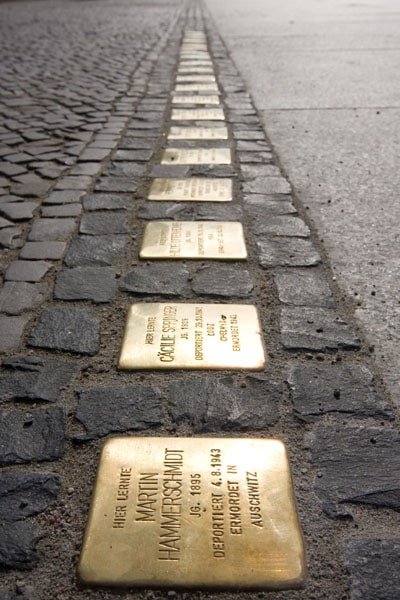Stolperstein in Stockholm, in memory of Curt Moses. Photo: Juliana Wiklund
On 14th June Stolpersteine or “stumbling stones” memorials were installed in front of three addresses in Stockholm, to commemorate three Holocaust victims, Jews that during 1930’s tried to escape from Nazi Germany by seeking refuge in Sweden, but their applications were refused and they were expelled from Sweden, basically – to the Nazis’ hands: Erich Holewa was forced to leave Sweden in 1938, and consequently deported to Auschwitz by the Nazis in 1942 where he was killed; Hans Eduard Szybilski was forced to leave Sweden in 1938 and later deported to Auschwitz in 1943 where he was killed; Curt Moses was forced to leave Sweden in 1937 and he was killed in Riga in 1941;
This was a great initiative by the Living History Forum, the Association of Holocaust Survivors (Föreningen Förintelsens Överlevande) and the Jewish Assembly in Stockholm (Judiska församlingen i Stockholm), in cooperation with the City of Stockholm. The Stolpersteine in Stockholm will remind us that the Holocaust was an unprecedented crime of pan-European character, involving even the countries that did not participated in the military aspects of the war (such as Sweden, Switzerland, Spain etc). Also, the Stolpersteine in Stockholm emphasizes our responsibility towards refugees, asylum seekers and other people who seek safe haven and protection, then – during the times of Nazi terror, as well as today.
Over 70,000 “stumbling stones” have been laid around Europe making the Stolpersteine project the world’s largest decentralized memorial.
Stolperstein in Osnabrück, Germany. Photo: Roland Mattern
Stolpersteine – a stumbling stone
Stolpersteine or “stumbling stone” project was initiated by the German artist Gunter Demnig in 1992. Stolpersteine is a concrete cube, 10×10 centimetres, bearing a brass plate inscribed with the name and life dates of victims of Nazi extermination or persecution. Stolpersteine are always installed in front of the last home of the victim (the home that victim had chosen freely – no hiding places, prisons etc).
Over 70,000 “stumbling stones” have been laid around Europe making the Stolpersteine project the world’s largest decentralized memorial. The majority of Stolpersteine commemorate Jewish victims of the Holocaust. Others have been placed for other victim groups, such as Roma, members of the Communist Party, the anti-Nazi Resistance, the physically or mentally disabled, and other victims, but also for German military deserters, escape helpers, and others.
Since 1992 when Stolpersteine was introduced in Germany, the following countries joined (in chronological order): Austria (1997), Netherlands (2007), Hungary (2007), Poland (2008), Czech Republic (2008), Belgium (2009), Ukraine (2009), Italy (2010), Norway (2011), Slovakia (2012), Slovenia (2012), France (2013), Croatia (2013), Luxemburg (2013), Russia (2013), Switzerland (2013), Romania (2014), Greece (2015), Spain (2015), Belarus (2016), Lithuania (2016), and as of 2019 – Sweden.
Stolperstein in Berlin. Photo: Yehuda Swed
Stolpersteine contributes to commemoration, education and culture of remembrance
Considering the scope and intensity of mass atrocities and killings, genocide and Holocaust in occupied Serbia committed by German Nazis, other occupying forces of Axis Powers countries (Hungary, Italy, Bulgaria, NDH Croatia), their local alias and collaborators, and considering how Stolpersteine effectively contributes to commemoration and education, and further the culture of remembrance in general, we would like to propose the initiative to install Stolpersteine memorials in Serbia, too.
We already took steps, and hope to be able to lay first Stolpersteine stones in Serbia in 2021.
According to the research conducted by Serbian leading Holocaust historian Dr Milan Koljanin, taking into consideration the whole territory of Serbia, including the territory under the German occupation and parts of Serbia annexed by Hungary, the Independent State of Croatia, Bulgaria and Italy, out of 34,777 Jews (including 1,200 Jewish refugees from the Central Europe), total of 28,224 or 81.16% of the Jewish population were killed during the Holocaust.
While Serbia still do not have a national Holocaust memorial or a Holocaust museum, Stolpersteine – stumbling stones – could remind us of once vivid Jewish communities in Belgrade, Zemun, Pančevo, Novi Sad, Niš, Zrenjanin, Subotica, Šabac, and many other places around Serbia.
We hope that by preserving the remaining authentic buildings of Judenlager Semlin at Staro Sajmište, as well as of concentration camp Topovske Šupe, both in Belgrade, Serbia will create a “memorial web, centered in the future commemorative complex in Sajmište”, as Dr. Milan Koljanin, one of the most famous Serbian historians, put it.
We already took steps, and hope to be able to lay first Stolpersteine stones in 2021.
Photo: Misko Stanisic – tower building at Staro Sajmiste, former Belgrade Fairground. During the German occupation of Serbia it was turned into Judenlager Semlin – a death camp where about 6,500 Jews were murdered in a gas-van, and later used as Detention Camp Semlin for at least 32,000 mostly Serbian inmates, of which 11,000 were killed. This authentic site is endangered and still not properly marked.
Stumbling stones in Serbia would contribute to a memorial web, centered in the future commemorative complex in Sajmište (in Belgrade).




